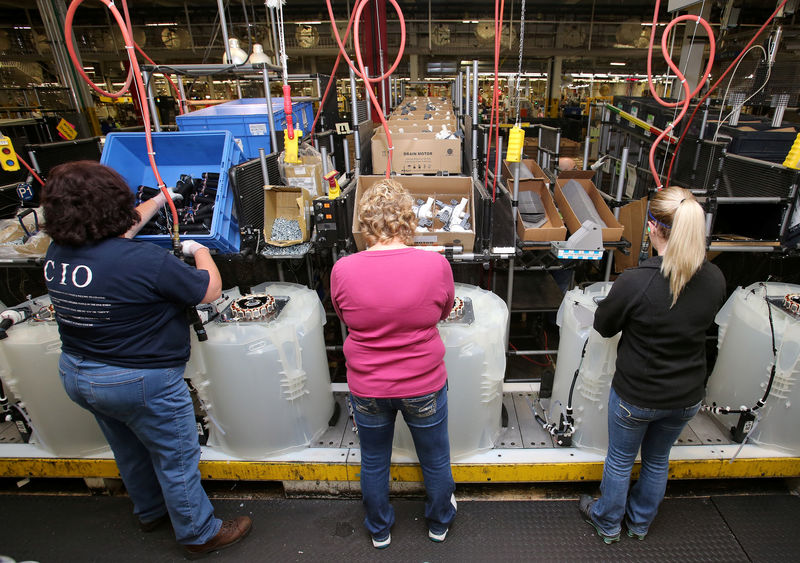Who is Kevin Hassett? Wolfe looks at the Trump ally tipped to become Fed Chair.
By Lucia Mutikani
WASHINGTON (Reuters) - U.S. worker productivity increased at its fastest pace in three years in the third quarter but the trend remained moderate, suggesting that a recent acceleration in economic growth was unlikely to be sustained.
Other data on Thursday showed the number of people filing for unemployment benefits fell to a near 44-1/2-year low last week, offering further evidence that the labor market was tightening despite hurricane-related disruptions in September.
The surge in productivity last quarter held down growth in labor costs, indicating that inflation pressures could stay benign for a while. Still, jobs market strength bolsters the case for the Federal Reserve raising interest rates in December. The U.S. central bank kept rates unchanged on Wednesday.
"While the data point to a solid economy, they also reinforce the view that growth is not likely to remain strong for an extended period without improved wage gains," said Joel Naroff, chief economist at Naroff Economic Advisors in Holland, Pennsylvania. "Productivity is still growing too slowly."
The Labor Department said nonfarm productivity, which measures hourly output per worker, rose at a 3.0 percent annualized rate. That was the quickest pace since the third quarter of 2014 and followed an unrevised 1.5 percent rate in the April-June period.
The rise outpaced economists' expectations for a 2.4 percent pace and was flagged in last week's third-quarter gross domestic product report, which showed the economy growing at a 3.0 percent rate during that period.
Productivity increased at a 1.5 percent rate compared to the third quarter of 2016. Manufacturing productivity fell at a 5.0 percent rate last quarter, the steepest rate of decline since the first quarter of 2009.
Overall, worker productivity has increased at an average annual rate of 1.2 percent from 2007 to 2016, below its long-term rate of 2.1 percent from 1947 to 2016. This, together with slowing population growth indicate the economy's potential growth rate has declined.
As such, analysts say the economy could struggle to achieve the 3 percent annual growth, which has been pledged by President Donald Trump. The Trump administration is pushing for big tax cuts and deregulation to achieve this goal.
Congressional Republicans on Thursday called for a range of changes to the U.S. tax code, including slashing the corporate tax rate and reducing the number of tax brackets for individuals.
The dollar fell against a basket of currencies on the Republican tax reform proposal, while prices for U.S. Treasuries rose. U.S. stocks were little changed.
PRODUCTIVITY RISE UNSUSTAINABLE
Eight years into the recovery, annual GDP growth has not exceeded 3 percent and economists do not expect the acceleration in productivity to be sustained.
"Given how long the expansion has lasted, we are not especially hopeful for much firming in productivity during the coming years," said Daniel Silver, an economist at JPMorgan (NYSE:JPM) in New York.
With productivity rising in the last quarter, unit labor costs, the price of labor per single unit of output, increased at only a 0.5 percent pace after rising at a 0.3 percent pace in the April-June quarter.
Compared to the third quarter of 2016, unit labor costs fell at a 0.1 percent rate, remaining negative for a second straight quarter. The weak growth in unit labor costs came despite hourly compensation rising at a 3.5 percent rate in the third quarter.
"This is a silver lining for corporations' bottom-lines that continue to benefit from contained labor costs despite the tightening in the labor market," said Gregory Daco, chief U.S. economist at Oxford Economics in New York.
In a second report on Thursday, the Labor Department said initial claims for state unemployment benefits decreased 5,000 to a seasonally adjusted 229,000 for the week ended Oct. 28, the Labor Department said. That was not too far from 223,000, a 44-1/2-year low touched in mid-October.
Last week marked the 139th straight week that claims remained below the 300,000 threshold, which is associated with a strong labor market. That is the longest such stretch since 1970, when the labor market was smaller.
The labor market is near full employment, with the jobless rate at a more than 16-1/2-year low of 4.2 percent.
The four-week moving average of initial claims, considered a better measure of labor market trends as it irons out week-to-week volatility, dropped 7,250 to 232,500 last week. That was the lowest reading since April 1973.
The low level claims suggest a surge in job growth in October after nonfarm payrolls dropped by 33,000 jobs in September as Harvey and Irma left some workers temporarily unemployed.
According to a Reuters survey of economists, the government's closely watched employment report due on Friday will probably show that payrolls increased by 310,000 jobs in October.
The claims report showed the number of people still receiving benefits after an initial week of aid fell 15,000 to 1.88 million in the week ended Oct. 21, the lowest level since December 1973, underscoring the diminishing jobs market slack.
